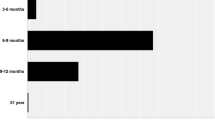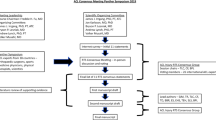Abstract
Purpose
The purpose of this study is to evaluate the reasons why athletes do not return to play (RTP) following anterior cruciate ligament (ACL) reconstruction from a large single-centre database.
Methods
The institutional ACL registry was screened for patients that had undergone a primary ACLR and had RTP status reported at 24-month follow-up. The reasons that patients were unable to RTP at 24 months were evaluated. The ACL-Return to Sport Index (ACL-RSI) was evaluated at baseline and 24-month follow-up to evaluate psychological ability to RTP.
Results
At 2 years, 1140 patients returned to play, and 222 had not returned to play. The most common reasons athletes were unable to return was fear of reinjury (27.5%), lack of confidence in performance on return (19.4%) and external life factors (16.6%), i.e. work commitments and family reasons. Other reasons for athletes not returning to play were residual knee pain (10%) and subsequent injury (5%). The ACL-RSI score was significantly lower at diagnosis (40.3 vs. 49.3; p = 0.003) and 2 years (41.8 vs. 78.7; p < 0.0001) in athletes who did not return to play vs. those that did RTP.
Conclusion
The majority of patients that report they have not returned to play do so due to external life and psychological factors associated with their injury, including fear of reinjury and lack of confidence in performance. A small minority of patients were unable to return due to residual knee symptoms or reinjury. Pre-operative psychological assessment and intervention may identify those less likely to RTP and provide an opportunity for targeted interventions to further improve RTP outcomes.
Level of evidence
III.
Similar content being viewed by others
References
Ardern CL, Taylor NF, Feller JA, Webster KE (2012) Fear of re-injury in people who have returned to sport following anterior cruciate ligament reconstruction surgery. J Sci Med Sport 15:488–495
Ardern CL, Taylor NF, Feller JA, Webster KE (2014) Fifty-five per cent return to competitive sport following anterior cruciate ligament reconstruction surgery: an updated systematic review and meta-analysis including aspects of physical functioning and contextual factors. Br J Sports Med 48:1543–1552
Ardern CL, Webster KE, Taylor NF, Feller JA (2011) Return to the preinjury level of competitive sport after anterior cruciate ligament reconstruction surgery: two-thirds of patients have not returned by 12 months after surgery. Am J Sports Med 39:538–543
Barry M, Thomas R, Rees A, Shafighian B, Mowbray MAS (1995) Effect of ACL reconstruction on meniscal and chondral lesions in the chronic anterior cruciate deficient knee. Knee 2:201–205
Beynnon BD, Johnson RJ, Abate JA, Fleming BC, Nichols CE (2005) Treatment of anterior cruciate ligament injuries, part I. Am J Sports Med 33:1579–1602
Beynnon BD, Johnson RJ, Abate JA, Fleming BC, Nichols CE (2005) Treatment of anterior cruciate ligament injuries, part 2. Am J Sports Med 33:1751–1767
Brewer BW (2010) The role of psychological factors in sport injury rehabilitation outcomes. Int Rev Sport Exerc Psychol 3:40–61
Cascio BM, Culp L, Cosgarea AJ (2004) Return to play after anterior cruciate ligament reconstruction. Clin Sports Med 23:395–408
Cupal DD, Brewer BW (2001) Effects of relaxation and guided imagery on knee strength, reinjury anxiety, and pain following anterior cruciate ligament reconstruction. Rehabil Psychol 46:28
Dingenen B, Gokeler A (2017) Optimization of the return-to-sport paradigm after anterior cruciate ligament reconstruction: a critical step back to move forward. Sports Med 47:1487–1500
Dunn WR, Spindler KP, Consortium M (2010) Predictors of activity level 2 years after anterior cruciate ligament reconstruction (ACLR): a multicenter orthopaedic outcomes network (MOON) ACLR cohort study. Am J Sports Med 38:2040–2050
Finsterbush A, Frankl U, Matan Y, Mann G (1990) Secondary damage to the knee after isolated injury of the anterior cruciate ligament. Am J Sports Med 18:475–479
Forsdyke D, Smith A, Jones M, Gledhill A (2016) Psychosocial factors associated with outcomes of sports injury rehabilitation in competitive athletes: a mixed studies systematic review. Br J Sports Med 50:537–544
Hagino T, Ochiai S, Senga S, Yamashita T, Wako M, Ando T et al (2015) Meniscal tears associated with anterior cruciate ligament injury. Arch Orthop Trauma Surg 135:1701–1706
Ivarsson A, Tranaeus U, Johnson U, Stenling A (2017) Negative psychological responses of injury and rehabilitation adherence effects on return to play in competitive athletes: a systematic review and meta-analysis. Open Access J Sports Med 8:27–32
Kvist J, Ek A, Sporrstedt K, Good L (2005) Fear of re-injury: a hindrance for returning to sports after anterior cruciate ligament reconstruction. Knee Surg Sports Traumatol Arthrosc 13:393–397
Kvist J (2004) Rehabilitation following anterior cruciate ligament injury: current recommendations for sports participation. Sports Med 34:269–280
Lee DY, Karim SA, Chang HC (2008) Return to sports after anterior cruciate ligament reconstruction - a review of patients with minimum 5-year follow-up. Ann Acad Med Singapore 37:273–278
Lynch AD, Logerstedt DS, Grindem H, Eitzen I, Hicks GE, Axe MJ et al (2015) Consensus criteria for defining 'successful outcome’ after ACL injury and reconstruction: a Delaware-Oslo ACL cohort investigation. Br J Sports Med 49:335–342
Maddison R, Prapavessis H, Clatworthy M (2006) Modeling and rehabilitation following anterior cruciate ligament reconstruction. Ann Behav Med 31:89–98
Meierbachtol A, Obermeier M, Yungtum W, Bottoms J, Paur E, Nelson BJ et al (2020) Injury-related fears during the return-to-sport phase of ACL reconstruction rehabilitation. Orthop J Sports Med 8:2325967120909385
Park S, Lavallee D, Tod D (2013) Athletes’ career transition out of sport: a systematic review. Internat Rev Sport Exerc Psychol 6:22–53
Podlog L, Eklund RC (2006) A longitudinal investigation of competitive athletes’ return to sport following serious injury. J Appl Sport Psychol 18:44–68
Podlog L, Eklund RC (2007) The psychosocial aspects of a return to sport following serious injury: a review of the literature from a self-determination perspective. Psychol Sport Exerc 8:535–536
Podlog L, Heil J, Schulte S (2014) Psychosocial factors in sports injury rehabilitation and return to play. Phys Med Rehabil Clin N Am 25:915–930
Rodriguez RM, Marroquin A, Cosby N (2019) Reducing fear of reinjury and pain perception in athletes with first-time anterior cruciate ligament reconstructions by implementing imagery training. J Sport Rehabil 28:385–389
Ross BJ, Savage-Elliott I, Brown SM, Mulcahey MK (2020) Return to play and performance after primary ACL reconstruction in American football players: a systematic review. Orthop J Sports Med 8:2325967120959654
Snoeker BA, Roemer FW, Turkiewicz A, Lohmander S, Frobell RB, Englund M (2020) Does early anterior cruciate ligament reconstruction prevent development of meniscal damage? Results from a secondary analysis of a randomised controlled trial. Br J Sports Med 54:612–617
Swirtun LR, Eriksson K, Renstrom P (2006) Who chooses anterior cruciate ligament reconstruction and why? A 2-year prospective study. Scand J Med Sci Sports 16:441–446
Tjong VK, Murnaghan ML, Nyhof-Young JM, Ogilvie-Harris DJ (2014) A qualitative investigation of the decision to return to sport after anterior cruciate ligament reconstruction: to play or not to play. Am J Sports Med 42:336–342
Tripp DA, Stanish W, Ebel-Lam A, Brewer BW, Birchard J (2007) Fear of reinjury, negative affect, and catastrophizing predicting return to sport in recreational athletes with anterior cruciate ligament injuries at 1 year postsurgery. Rehabil Psychol 1(52):74
Funding
There are no sources of funding to declare.
Author information
Authors and Affiliations
Corresponding author
Ethics declarations
Conflict of interest
The authors declare that they have no conflict of interest.
Ethical approval
Ethical approval was granted by the Sports Surgery Clinic IRB.
Additional information
Publisher's Note
Springer Nature remains neutral with regard to jurisdictional claims in published maps and institutional affiliations.
Rights and permissions
About this article
Cite this article
Toale, J.P., Hurley, E.T., Hughes, A.J. et al. The majority of athletes fail to return to play following anterior cruciate ligament reconstruction due to reasons other than the operated knee. Knee Surg Sports Traumatol Arthrosc 29, 3877–3882 (2021). https://doi.org/10.1007/s00167-020-06407-5
Received:
Accepted:
Published:
Issue Date:
DOI: https://doi.org/10.1007/s00167-020-06407-5




